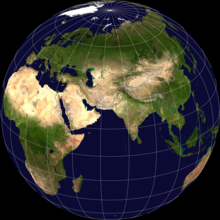Afro-Eurasia
Africa-Eurasia
_(W3).svg.png)
![]()
The large continent of Africa-Eurasia, also called Afro-Eurasia, Eurafrasia or European Africa, contains the largest contiguous landmass on Earth.
In biogeography and in the humanities and social sciences, this land mass is preferably referred to as the Old World.
Africa-Eurasia is not identical with the Eastern Fortress. This outdated term usually includes Australia, among others.
General
In keeping with its name, Africa-Eurasia is made up of the continents of Africa and Eurasia (Europe and Asia). With an area of about 85 million square kilometres, Africa-Eurasia covers one sixth of the earth's surface and comprises well over half of all the earth's mainland. With a population of 6.1 billion people (as of 2013), the continent is home to around 87% of the world's population.

Subdivision
As in the case of Eurasia, many scholars argue that the division of the "world island" is not justified and is merely historical and cultural. Traditionally, the boundary between Africa and Eurasia is considered to be the Isthmus of Suez.
Origin
In terms of Earth history, Africa-Eurasia is relatively young and has existed in its present form for about 20 million years. After the disintegration of the supercontinent Pangaea in the Mesozoic, Eurasia, together with North America, belonged to the "northern continent" Laurasia, while Africa was part of the "southern continent" Gondwana (along with South America, Australia, Antarctica and India), two landmasses completely separated by the Tethys Ocean. After the disintegration of Gondwana, Africa and India began to move northwards in the Cretaceous and collided with Eurasia in the Palaeogene and Neogene.
In about 50 million years, the collision of Africa with Europe will cause the Mediterranean to close and a mountain range comparable to the Himalayas to rise in its place.
Questions and Answers
Q: What is Africa-Eurasia?
A: Africa-Eurasia (also called Afro-Eurasia, Eurafrasia, or Afrasia) is the world's biggest landmass. It is split between the two continents of Africa and Eurasia.
Q: How much of the world population lives in Africa-Eurasia?
A: Around 85% (approximately 5.5 billion) of the world population lives there.
Q: What are some other names for Africa-Eurasia?
A: Other names for Africa-Eurasia include Afro-Eurasia, Eurafrasia, and Afrasia.
Q: What areas make up the Old World?
A: The Old World includes Africa-Eurasia and its surrounding islands such as Eurasian Asia, Northern Asia, Western Asia, Central Asia, Eastern Asia, Southern Asia Southeastern Asia Europe Northern Europe Western Europe Eastern Europe Southern Europe Africa Northern Africa Western Africa Central Africa Eastern African Southern African.
Q: When is it expected that Spain will reach the tip of North African coast?
A: One estimate suggests it will happen in 600,000 years when the southern tip of Spain reaches North African coast.
Q: When will Mediterranean Sea be isolated from Atlantic Ocean due to collision between Europe and North African coast?
A: If this happens (collision between Europe and North African coast), Mediterranean Sea will be isolated from Atlantic Ocean.
Q: When is it expected that complete collision between Europe and North African Coast will take place?
A: It is expected that complete collision between Europe and North African Coast will take place in 50 million years which would close off Mediterranean Sea from Atlantic Ocean completely.
Search within the encyclopedia